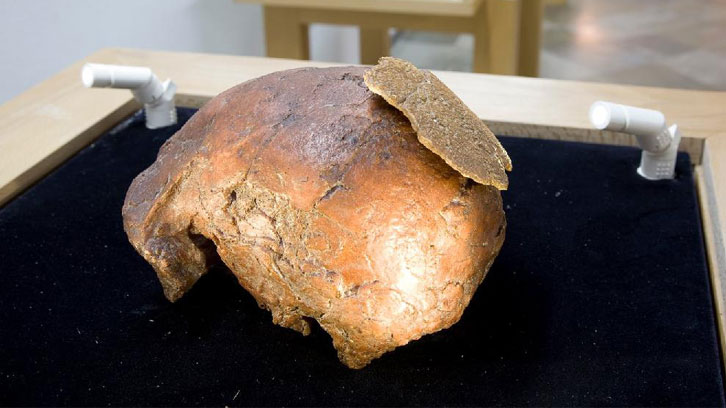A Country’s Obsession During the Construction of a Democracy: "Is the Orce Man our ancestor?"

In 1983, a skull fragment found at a site in the village of Orce (Granada, Spain) was presented. It became the remains of the first European, the Orce Man. One year later, part of its discoverers and other scientists retracted the claim and attributed the bone to a member of the genus of prehistoric horses and donkeys, making it “the Orce Donkey”. This thesis reconstructs the controversy, highlighting the role of the political, scientific and media context in the manner in which the Orce Man was interpreted, announced, discussed and finally discarded.
|
|
||
| Figure 1. Image of the three discoverers in 1983, at a time of great media attention (Source: El País, EFE). | ||
|
|
||
| Figure 2: Part of the interior of the skull fragment before (right) and after (left) cleaning (Source: Colección Historicomédicade la Universitat de València). | ||
|
|
||
| Figure 3: Cover of the old satirical magazine El Papus, num. 525, June 1984. | ||
To find out we have to go back a year earlier. In June 1983, the discovery of a skull fragment was announced in a room full of journalists. Despite the fact that it was attached to a rock and its inner part was not be visible, it seemed to belong to an ancestor of man and could therefore cause a revolution in human paleontology, becoming the oldest remains on the continent, the First European. The discovery was made at a site in the small town of Orce in the province of Granada by three young Catalan researchers: Josep Gibert, Jordi Agusti and Salvador Moyà-Solà. The press received the discovery enthusiastically, with pompous headlines such as the "Discovery of the Century", and devoted much attention to the scientists, in particular to Gibert, who became a public figure. The presentation was attended by the President of the Barcelona Provincial Council (Diputació de Barcelona), and the Head of Culture of the Andalusian government (Junta de Andalucía) who signed a scientific collaboration agreement. Why was such political attention given o the finding?
To discover this, once again we must go back in time. These are the years of democratic consolidation in Spain, after Franco’s long dictatorship, and the new autonomous powers were at stake in both Catalonia and Andalusia. With the creation of the Catalan Government, the Provincial Council of Barcelona, which concentrated power during the dictatorship, was losing prominence. Yet, it was trying to survive in the new situation, among other issues, by focusing its control on cultural and museum policies. In this context, when the three discoverers, who at that time were very young and did not hold permanent positions, realised the importance of the discovery, they went to see the politicians of the Provincial Council in charge of their scientific institution, the Institut de Paleontologia de Sabadell. These politicians received the finding with open arms, organised the presentation and promised funding for the researchers. Then the discovery was published in the journal of the Institut de Paleontologia and international scientists, such as the French couple Henry and Marie-Antoinette de Lumley, examined the fragment and confirmed the three discoverers’ opinions. At this point we can therefore understand - due to the media’s attention - the reference to the Orce Man made by Siniestro Total, but why the interrogative tone?
To make it clear we must return to a few months after the presentation of the fragment. In April 1984, the inside part of the skull gave a surprise to the trio of discoverers. After separating it from the rock, a ridge appeared that clashed with the supposed human characteristics. Given this dilemma, the three researchers decided to take the fragment to Paris to show it again to the de Lumley couple. There, Marie-Antoinette, an expert on anatomy, reached the conclusion that the famous Orce man belonged, in fact, to a member of the genus of prehistoric horses and donkeys, Equus. Agustí and Moyà-Solà accepted the verdict of the French senior researchers, but Gibert rejected it. Given this rejection, the de Lumleys made a crucial movement. The next day, the newspaper El Pais published, on the front cover, the doubts regarding the Orce Man, quoting Marie-Antoinette as its scientific source. A major public controversy exploded. The early public attention given to the discovery led to a profusion of news with the dispute. The Orce Man became the Orce Donkey and Gibert emerged as the only defender of the hominid. In 1987, Agustí and Moyà-Solà published the first scientific paper presenting the fragment as being attributed to the genus Equus. First, however, the novelty had appeared in all the newspapers.
This thesis is a reconstruction of the Orce Man controversy which highlights the role of the political, scientific and public context in the way the discovery was interpreted, publicly presented, discussed and later discarded. New scientific knowledge was no longer discussed only in the scientific arena but also in the public media, which adopted an important role in the scientific debate. Siniestro Total’s song is just an example of how the debate around the Orce Man became an important issue in Spanish public opinion. Today, more than thirty years later, the Orce Man is generally not accepted in the scientific community. However, in the brand new Museum of Prehistory “Josep Gibert” in Orce, this tiny cranial fragment continues to hold a dominant position, a position that only can be understood if, as this thesis does, one goes back in time to a few years ago.
Figure 4: News in El País on doubts about the skull fragment (Source: Relaño, Alfredo, El País. 12 May 1984).
References
“Orce Man. A Public Controversy in Spanish Human Origins Research, 1982-2007”, PhD thesis by Miquel Carandell Baruzzi, supervised by Oliver Hochadel and Agustí Nieto-Galan, within the PhD programme in History of Science.


